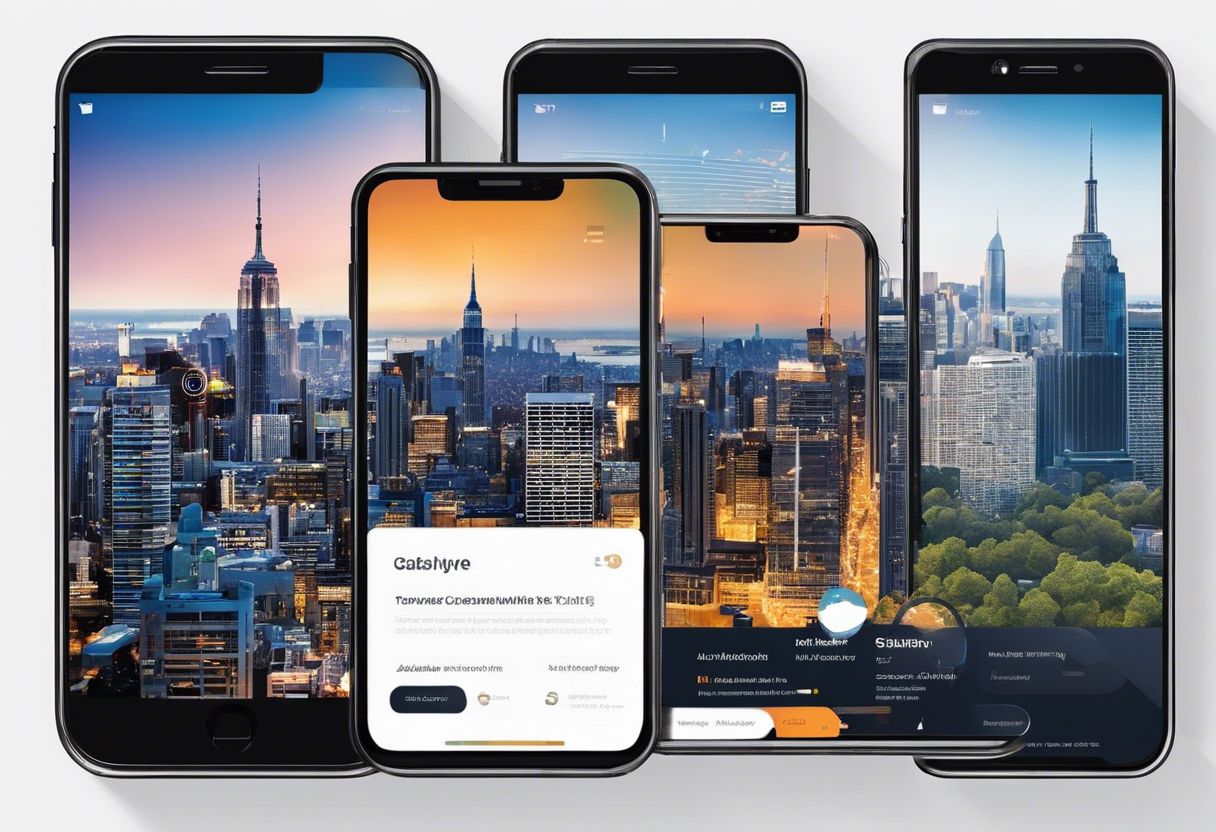Web Technologies and Trends: What’s Hot Right Now

Hey there, small business owners! Let’s talk about web technologies and trends. These are the tools and ideas that make websites work better and look cooler. Right now, things like cloud computing, AI, special tools for phones, and making sites easy to use on any device are super important.
Businesses should use these to stay ahead and give people a great time online.
In 2023, there are some hot trends we’re seeing in web development. Things like Progressive Web Apps (PWAs) act like both websites and apps you can add to your phone screen – cool right? And then there are Single-Page Applications (SPAs), which make websites run smoothly without loading new pages constantly.
AI is big news too. It helps with chatbots that can talk to customers right away or checking code automatically so it’s top-notch. Plus, testing everything without humans means fewer mistakes!
Having a website look good on phones, tablets, or computers is crucial as well – that’s where responsive design comes in handy. We’ve also got fancy designs moving around on screens (Motion UI) and lots of sites using dark mode because it’s easier on the eyes.
Keeping all this safe is key too; improved security efforts are everywhere in tech land.
Back-end developers have new toys as well with serverless setups saving time and headaches. Clouds aren’t just in the sky anymore; they’re also storing our data for quick access from anywhere.
Front-end folks aren’t left out either – JavaScript keeps getting better along with other frameworks making building sites faster.
And looking forward? Get ready for more AI helping users directly through their journeys online while mixing old-school style with high-tech feels for site designs next year!
Now let’s get into all this a bit more because understanding it could really help your business shine online!
The State of Web Development in 2023

The state of web development in 2023 is constantly evolving, with new technologies and trends shaping the digital landscape. From progressive enhancements to the rise of AI and automation, web developers are embracing innovative approaches to create more dynamic and user-friendly experiences.
A Quick Overview of Current Trends

Web development today means making websites that work well on phones and computers. We see a lot of single-page applications (SPAs) which load faster and feel smoother for users. They are a big deal now because they make websites act more like apps.
Voice search is also getting popular. People can now talk to their devices to find what they need, making it important for your website to understand spoken words. This trend is just taking off and will likely get even bigger in 2023.
We know our stuff about web design and user experience, so let’s keep these trends in mind as we explore the exciting world of progressive enhancements next!
Progressive Enhancements for the Modern Web

Embracing progressive enhancements such as PWAs, AMPs, and SPAs can greatly improve user experience and boost website performance. Read on to discover how these modern web technologies are shaping the future of online experiences.
Progressive Web Apps (PWAs)
-151531272.jpg)
We know you’re always looking for ways to reach more customers and make your website shine. Have you heard about Progressive Web Apps (PWAs)? These are like superheroes for your website! They give users a top-notch experience just like they’re using an app, but right in their browser.
Think of it as getting the best parts of mobile apps without the fuss.
Imagine your customer tapping on a branded icon on their phone screen and jumping straight into shopping with you. That’s what PWAs do; they live on the user’s home screen, work fast, and keep folks coming back.
Our goal is to help you grab these benefits. With PWAs, we can boost user engagement together by offering easy access and smooth browsing — no need for customers to download anything from an app store!
Accelerated Mobile Pages (AMP)
-151531122.jpg)
Accelerated Mobile Pages, or AMP for short, make our websites a lot faster. Think about when you’re on your phone and a page takes forever to load. That’s annoying, right? Well, AMP fixes that by using special code to speed things up.
This is super important because most people will leave if a website doesn’t show up quickly on their phones.
As small business owners, we want everyone to enjoy visiting our sites without any slow-downs. With AMP, not only do pages pop up fast on phones but they work great on computers too! We get the best of both worlds—quick loading times and happy customers ready to buy what we sell.
Next up are Single-Page Applications (SPA), another cool technology that makes browsing smooth and seamless for users.
Single-Page Applications (SPA)
-151531737.jpg)
Now, let’s delve into Single-Page Applications (SPAs), another vital component of modern web development. SPAs have gained significant traction due to their ability to provide a seamless user experience.
These JavaScript-based applications load only a single page initially and then dynamically rewrite the page with new content from the web server, eliminating the need for entire page reloads.
This results in faster and more fluid interactions for users as they navigate through different sections of the website or application.
Brands such as Gmail and Facebook harness the power of SPAs for their web applications, revolutionizing how users interact with content online. With SPAs, businesses can offer dynamic and responsive experiences that keep users engaged by delivering content in a more intuitive manner.
The Rise of AI and Automation in Web Development

AI and automation are revolutionizing web development, with AI-powered chatbots enhancing user engagement and automation testing streamlining the development process. Automated code review tools are also improving efficiency and accuracy in identifying potential issues.
These advancements are shaping the future of web development, making it more efficient and user-centric.
AI-Powered Chatbots

AI-powered chatbots are a game-changer for small businesses. These virtual assistants use AI and machine learning to enhance customer service and user engagement on websites. By leveraging these modern technology advancements, businesses can provide real-time assistance to users, thereby improving the overall experience.
Implementing AI-powered chatbots not only lowers costs but also keeps your business at the forefront of modern website development trends. Companies like Intercom offer chatbot solutions that seamlessly integrate into websites, apps, or other software to create a more engaging user experience.
With AI-powered chatbots becoming increasingly popular among both businesses and consumers, it’s clear that they have become essential for modern web development. Leveraging customer data and natural language processing, these chatbots play a vital role in delivering interactive support while streamlining operations.
Automation Testing
As we navigate through the realm of AI-powered chatbots, it’s essential to acknowledge the rise of AI and automation in web development, particularly in the domain of automation testing.
In 2023, the integration of Artificial Intelligence (AI) is a significant trend reshaping the landscape of automated testing. Machine Learning (ML) plays a pivotal role in this paradigm shift, enabling early-stage testing and codeless automation to streamline the testing process.
Hyperautomation, which merges AI capabilities with traditional automation tools, represents an emerging trend that small business owners must leverage for efficient market growth.
The market value of automation testing stands at a substantial USD 20 billion and is expected to grow at an impressive Compound Annual Growth Rate (CAGR) of 15% between 2023 and 2032.
Looking ahead into the future, upcoming technologies such as blockchain will further underscore the criticality of effective test automation practices shaped by AI and ML integration.
Automated Code Review
Moving on from automation testing, let’s delve into the realm of automated code review. In today’s web development landscape, AI-powered code review tools are gaining momentum as they provide comprehensive, context-aware assessments of web application code.
These tools offer automated code analysis and evaluation, enabling developers to improve the quality and efficiency of their code without extensive manual intervention.
By leveraging automated code review solutions such as AI-driven assessment and context-sensitive inspections, small business owners can ensure that their web applications meet industry standards while optimizing development processes.
Optimizing User Experience

In the fast-paced world of web development, optimizing user experience is key. From responsive websites to motion UI design and standardizing dark mode, staying ahead of the curve in user experience trends can make or break a business’s online presence.
Responsive Websites
We make sure our website looks great on any device. It’s important that when customers visit the site, it works well whether they’re using a phone, tablet, or computer. We do this by designing our website to adapt and fit perfectly on all types of screens.
This way, no matter how someone is looking at our site, it always looks professional and easy to use.
We focus on making images load quickly so that visitors don’t have to wait for the page to show up. By doing this, we make sure people enjoy their time on our website without getting frustrated with slow loading times.
Motion UI Design
After ensuring that your website is responsive on various devices, the next step to optimize user experience is through Motion UI Design. This trend involves using animation and transition effects in user interface design to create a more engaging and interactive experience for visitors.
With motionsensing technology, designers can tell compelling stories through design while enhancing the overall user experience. It’s important for small business owners to consider Motion UI as a critical modern advance in web development trends, as it allows for completely responsive site designs and speeds up the UI design process.
Embracing this trend can lead to innovations in optimizing UX for different devices and technologies, which will ultimately benefit your business.
Dark Mode Standardization
After exploring the concept of Motion UI Design, let’s shed some light on Dark Mode Standardization. In today’s digital landscape, dark mode has become a prevalent trend due to its numerous benefits for users.
It not only offers visual comfort and reduces eye strain but also contributes to energy savings in web technologies. Implementing dark mode in your website can enhance user experience by providing an alternative color scheme that aligns with user preferences while promoting accessibility and accommodating varying screen brightness.
Dark mode optimization is crucial as it addresses the need for accommodating different user preferences, especially regarding visual comfort and reduced eye strain. By standardizing dark mode across websites, small business owners can ensure that their platforms are inclusive and visually appealing to a wide range of users.
Security and Privacy in the Spotlight

As web technologies continue to evolve, it’s crucial to prioritize security and privacy measures for your online presence. Stay ahead of potential threats and ensure user data protection by understanding the latest advancements in native cybersecurity and data compliance.
Embrace the changes in web development with a focus on safeguarding digital assets and maintaining trust with your audience. Curious to learn more about how you can enhance security for your website? Keep reading!
Improved Native Cybersecurity
We are witnessing an exciting time in cybersecurity with the evolution of native security measures. Enhanced security technologies, such as advanced threat detection and insider threat prevention, are reshaping the landscape.
Machine learning algorithms play a vital role in bolstering cybersecurity innovation by providing better privacy protection and data breach prevention. These improvements offer small business owners enhanced network security and privacy controls, ensuring greater peace of mind when it comes to safeguarding their digital assets.
Moreover, innovative cybersecurity products are gaining attention for their comprehensive approach to cyber defense technology. They provide small businesses with practical benefits like improved threat monitoring and proactive measures against potential breaches.
Data Compliance Measures
In our constantly evolving digital landscape, data compliance measures have become integral for businesses. Protecting consumer privacy and ensuring information security are critical aspects in the current climate.
Maintaining compliance with privacy laws, such as GDPR and CCPA, is essential to establish trust and integrity with customers while avoiding potential legal repercussions. Implementing comprehensive data security measures not only safeguards sensitive information but also demonstrates a commitment to ethical business practices.
Understanding and adhering to regulatory compliance isn’t just about following the rules; it’s about building a foundation of trust with your customers.
As small business owners, prioritizing data protection initiatives can be instrumental in establishing credibility and reliability in the eyes of your clientele. Embracing stringent data governance practices doesn’t just mitigate risk; it promotes an environment where consumer data privacy is respected at every touchpoint.
Innovations in Back-End Development

Serverless architecture and cloud computing solutions are revolutionizing the way back-end development is approached, offering more flexibility and scalability for modern web applications.
To learn more about how these innovations can benefit your business, keep reading!
Serverless Architecture
Innovations in back-end development have brought about serverless architecture, a game-changer for small businesses. This technology allows us to focus entirely on our product without the hassle of managing infrastructure.
With serverless computing, cloud computing becomes more efficient and scalable as it eliminates the need for backend management. This means we can deploy applications with greater flexibility and security measures while ensuring reliability.
Serverless architecture adoption is rising as cloud platforms like AWS Lambda are seeing a 3.5X increase in triggers, indicating its growing popularity among enterprises. It’s important to note that this trend offers practical benefits such as better scalability, efficiency, and security measures—a significant advantage for small business owners seeking reliable application deployment on cloud platforms.
Cloud Computing Solutions
Cloud computing is a game-changer for small businesses like ours. It’s all about using remote servers over the internet to store, manage, and process data instead of relying on our own hardware.
This means no more worrying about physical infrastructure – we can access everything we need online! Cloud technology also offers services such as Infrastructure as a Service (IaaS), Platform as a Service (PaaS), and Software as a Service (SaaS).
With these solutions, we can scale up or down based on our needs and only pay for what we use. Plus, it allows us to access powerful software without having to install anything locally.
Shifting to cloud computing offers practical benefits like improved accessibility, flexibility, and cost-effectiveness. We won’t have to worry about maintaining physical servers or dealing with unexpected downtimes anymore.
Front-End Development: New Directions

JavaScript frameworks are evolving rapidly, with new tools and libraries constantly emerging to improve front-end development. To learn more about the latest advancements in web technologies and trends, keep reading!
JavaScript Frameworks Evolving
JavaScript frameworks have been rapidly evolving to meet the growing demands of modern web applications. With scalability and user interface in focus, frontend programming has seen a significant shift towards component-based architecture, enabling enhanced performance and flexibility.
The popularity race in web development continues to be led by JavaScript, with the proliferating emergence of new frameworks further driving innovation in frontend development.
The big revolution in front-end development was the change to component-based frameworks like React, Angular 2+, and Vue. This shift brought about major improvements in user experience and application performance.
These frameworks, along with emerging ones, address critical challenges at scale and reveal the recent evolution of frontend architecture.
As web technologies continue to advance rapidly, staying updated with these evolving JavaScript frameworks is crucial for small business owners aiming to keep their online presence competitive.
Meta-Frameworks and Monorepos
As we delve into the ever-evolving world of front-end development, let’s pivot our focus to Meta-Frameworks and Monorepos. Embracing Meta-Frameworks can streamline your frontend development process by providing a single entry point for utilizing multiple frameworks, ensuring a more efficient and consistent coding experience.
This approach enables you to harness the strengths of various frameworks while maintaining code organization. Additionally, employing monorepos allows you to manage multiple related software products within a single repository effectively.
With this strategy, versioning becomes unified, making it easier to track changes across different projects.
Moreover, adopting these practices aids small business owners in optimizing their workflow efficiency and enhancing collaboration among developers working on diverse software components within a project.
Headless CMS Architecture
Small business owners, let’s talk about headless CMS architecture. This innovative approach decouples content management from the presentation layer of your website or application.
It permits you to maintain and organize your content without being tied to a specific frontend technology, ensuring flexibility and adaptability as new frontend technologies emerge.
Furthermore, it enables seamless integration with ecommerce platforms, offering improved content delivery and user experience for digital commerce. By embracing headless architecture, you can future-proof your online presence while effectively managing your content across various channels.
Emerging Technologies Reshaping the Web

Emerging technologies such as blockchain, Internet of Things (IoT), and virtual reality (VR) are reshaping the web development landscape. These advancements have the potential to revolutionize how websites and web applications are built, providing new opportunities for innovation and user engagement.
Blockchain Technology
Blockchain technology is reshaping the web, offering decentralized networks and enhancing data security. This revolutionary tech extends beyond isolated solutions to connect various industries and sectors through distributed ledger technology.
Smart contracts driven by blockchain are catalyzing shifts in web development and the global economy, promoting trustless transactions and securing financial operations. As small business owners, understanding how blockchain influences diverse industries can help us stay ahead of the curve and leverage its potential to improve our operations.
The impact of blockchain goes further, with trends such as NFTs transforming digital assets, specifically influencing the Internet of Things (IoT) and cybersecurity. Furthermore, augmented reality (AR) is set to revolutionize education on future internet platforms alongside virtual reality (VR), indicating a dynamic shift that small businesses should be prepared for.
Internet of Things (IoT)
Now let’s shift our focus from blockchain technology to the Internet of Things (IoT). The IoT refers to the vast network of internet-connected physical devices worldwide. These connected devices, such as smart technologies and sensor-equipped gadgets, are revolutionizing the way we live and do business.
For small business owners, IoT offers a wealth of opportunities for digital transformation and operational enhancement.
Imagine having access to real-time data analytics from your production machinery or being able to remotely monitor inventory levels. With IoT, these capabilities are within reach. This technology introduces automation through interconnected systems, harnessing cloud computing and artificial intelligence to optimize processes.
Virtual Reality (VR) and Augmented Reality (AR)
The Internet of Things (IoT) is transforming the way we interact with technology, and now let’s dive into how Virtual Reality (VR) and Augmented Reality (AR) are reshaping user experiences.
These immersive technologies offer interactive experiences that significantly enhance customer satisfaction and brand engagement. The impact of VR and AR on businesses today is substantial, but it doesn’t stop there.
As for future predictions, these emerging technologies have the potential to revolutionize web development trends by creating captivating user experiences through XR technology, ultimately affecting business impact positively.
Large data volumes needed to run XR may pose a challenge in the future, but despite this obstacle, VR and AR are undoubtedly leaving an indelible mark on web development trends with their ability to create deeply immersive experiences for users.
2024 Website Design Trends: Staying Ahead with Latest Styles

We’ve got our eyes on the latest website design trends for 2024, and here’s what small business owners need to know. User interface (UI) focus is a big trend right now, ensuring that websites are not just visually appealing but also easy to navigate.
Machine learning is making its mark in predicting user behavior and optimizing user experience (UX). And speaking of looks, minimalism and retro futurism are stealing the show – think simplistic and futuristic styles with color transitions.
Additionally, vintage aesthetics are making a comeback along with scroll animations that bring websites to life. Gradients are back in fashion too! These trends mean designers might have their work cut out for them as they keep up with these constantly evolving styles.
So buckle up; it’s going to be an exciting ride as we embrace these fabulous web design trends of 2024!”
Navigating the Web Development Landscape

Stay ahead of the game by understanding core web vitals and SEO, incorporating web assembly for improved performance, and exploring the possibilities of no-code/low code development.
Discover how these strategies can elevate your online presence and drive success in today’s digital landscape. Read on to learn more about navigating the ever-changing world of web development.
Core Web Vitals and SEO
In 2024, Core Web Vitals play a critical role in website performance and user experience. They measure page loading speed, interactivity, and visual stability. Here’s what small business owners need to know:
- Page Loading Speed:
- Ensures quick loading of web pages.
- Faster loading improves user satisfaction and SEO rankings.
- Interactivity:
- Measures responsiveness to user input.
- Enhances user engagement and overall site performance.
- Visual Stability:
- Focuses on preventing unexpected layout shifts.
- Provides a seamless browsing experience for users.
WebAssembly for Performance
As we navigate the web development landscape, one key technology that’s revolutionizing application performance is WebAssembly. This innovative technology enables high-performance code execution directly within web browsers.
By harnessing WebAssembly, businesses can ensure faster and safer web applications, leading to enhanced user experiences and improved security measures. With its ability to bring high performance to web applications, WebAssembly is at the forefront of reshaping the future of web development and ensuring superior application performance for small business owners.
Harnessing WebAssembly ensures that code execution on browsers achieves a new level of speed and efficiency. This translates into significant improvements in the overall user experience as well as enhanced security for web applications – essential elements for any modern small business navigating today’s competitive digital landscape.
No-code/Low Code Development
We’re at the forefront of a revolution in web development with no-code/low code platforms. These tools simplify and speed up the application development process, making it easier for everyone to create web applications with minimal coding.
With features like visual development, drag-and-drop interfaces, and automation, these platforms are reducing barriers to entry for enterprise developers and citizen developers alike.
Moreover, by 2024, low-code application development is predicted to dominate web development. As a small business owner looking to implement digital transformation or streamline business processes without extensive technical knowledge, embracing no-code/low code platforms can be a game-changer.
The Future Is Now: Web 3. 0 and Beyond

As technology continues to advance, we are on the brink of a new era in web development. Web 3.0 is set to revolutionize the way we interact with the internet, incorporating concepts like blockchain, Typescript, and ambient design considerations to create a more immersive and intuitive user experience.
This evolution in web technology opens up new opportunities for businesses to engage with their audiences in innovative ways.
Understanding Web 3.0
Web 3.0, also known as the decentralized web, is all about giving more power to you, the user. It’s like taking control of your online experience. This new kind of internet uses fancy technology to make things easy and safe for you.
Imagine talking with a website just like chatting with a friend – that’s what Web 3.0 aims for! Plus, it makes sure everything is super secure because it uses powerful tricks like encryption and blockchain.
We’re not done yet! Web 3 technologies are smart cookies; they understand how people talk and think. They use machines called AI (that’s short for artificial intelligence) to do this cool trick called natural language processing.
With Web 3.0, surfing the net becomes much cooler than before – it’s like having your own personal assistant guiding you through the online world!
The Role of Typescript
As small business owners, it’s essential to recognize the pivotal role TypeScript plays in web development. TypeScript is not just another programming language; it’s a game-changer for the future of web development.
It brings several advantages like improving developer productivity, enhancing application architecture, and ensuring code scalability. With 77% of frontend developers already using TypeScript and its seamless compatibility with Node backends, embracing this technology can give your business an edge.
Its growing popularity and easy integration into various integrated development environments make it a vital asset to stay ahead in the fast-evolving digital landscape.
Incorporating TypeScript into your web development strategy isn’t just about following trends; it’s about harnessing a tool that enhances your development experience while boosting your applications’ potential.
Ambient Design Considerations
Transitioning from exploring the role of TypeScript to understanding ambient design considerations, we delve into the realm of ubiquitous technology and integrated computing. As small business owners navigating the fast-paced world of web development, it becomes imperative to grasp the concept of ambient computing, where everyday environments are seamlessly intertwined with computing integration.
The user interface design is at the forefront as augmented reality (AR) and virtual reality (VR) present new challenges that require innovative solutions.
Consequently, embracing these future technologies necessitates a proactive approach in addressing design obstacles within this ambient interface landscape. With an eye on creating immersive digital experiences while ensuring seamless interaction between users and technology, understanding and implementing effective ambient design considerations will be instrumental in staying ahead in web development.
Conclusion: Embracing Change in Web Development

Web technologies are rapidly evolving, and staying updated is crucial for businesses. The shift towards cloud computing and artificial intelligence offers scalability and enhanced user experiences.
Embracing these trends can set your business apart in the competitive online landscape. By adapting to the latest web development trends, entrepreneurs can leverage new technologies to stay ahead of the competition while providing outstanding user experiences.
Let’s embrace change and navigate the future of web development with confidence!
FAQs
1. What are the latest trends in web technologies?
The latest trends in web technologies include progressive web apps, single-page applications, motion UI, and chatbots.
2. How can I stay updated with current web development trends?
You can stay updated with current web development trends by following tech blogs, attending conferences or meetups, and networking with other professionals in the field.
3. Is it necessary to learn new web technologies to stay relevant?
Yes, learning new web technologies is important to stay relevant as the industry evolves rapidly. Continuous learning helps you adapt to changing demands and remain competitive.
4. Are there any emerging programming languages for web development?
Yes, emerging programming languages for web development include TypeScript, Dart (for Flutter), Kotlin (for Android), and Rust for system-level programming.
5. How can businesses benefit from adopting modern web technologies?
Businesses can benefit from adopting modern web technologies through improved user experience, faster loading times, better security features, and enhanced scalability of their online platforms.


